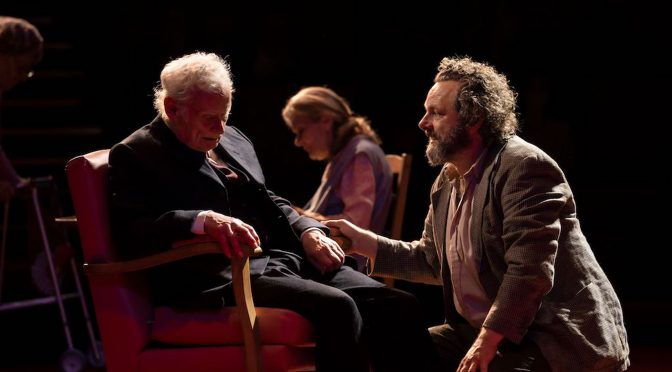Poetry on stage is never easy. And when Dylan Thomas’s text comes with the legacy of a famous reading (Richard Burton, no less) a new production becomes even trickier. Lyndsey Turner’s brave attempt benefits from a star draw and strong performances from a large cast, but struggles to deliver anything new or to please old fans.
The big idea is to start the play within a care home. Additional material is provided by Siân Owen. Our narrator (Michael Sheen) jogs the memory of his dementia-suffering father (Karl Johnson). Thomas’s themes of memory and mortality are clear. But this preface (how could it be considered anything else?) makes the show longer than needed. And an hour and three quarters without an interval and wearing a mask feels very long indeed.
Maybe you have the patience. But while the show feels lengthy, the delivery – undoubtedly impressive – is too often rushed. And this is not an easy text to follow. Turner, with the help of movement director Imogen Knight, has taken the challenge of bringing a ‘play for voices’ to the stage vigorously. The lives of those living in Milk Wood come and go with alarming speed.
It’s easy to enjoy the cast, who take on the roles of villagers as “one spring day” goes by. I’d single out Alan David as making me laugh the most, while Siân Phillips manages to convey different ages of characters quite magically. There are nice touches with minimal props and excellent costume changes (bravo, set and costume designer Merle Hensel). Emotional moments between father and son are highlighted by the issue of alcoholism, and the “always open” Sailors Arms pub is a vivid presence within the play.
Thomas was not nostalgic. You can imagine the temptation… all those simple lives in an easier past. There is charm and humour here but, admirably, Turner avoids rose tints. A call to observe the balance between seeing the best and worst sides of people has weight as a result.
Sheen can command a stage. And he sounds fantastic. But with a show this dark – literally – and often pin-drop-quiet, it’s all too easy to slip from the level of concentration he brings to the role. The “noise of the hush” is an exquisite phrase to describe the life of this community… the trouble is that I heard a snore above it more than once. This production is an achievement on the part of its cast. Unfortunately, it requires a feat of endurance for an audience.
Until 24 July 2021


